A first Food and Bioprocess Engineering Night was held at 0D26 of the Engineering Building at the University of Saskatchewan (U of S) on April 10, 2019.
The main goal of having the event was to promote CSBE and link between researchers and industries in Food and bioprocess Engineering sector through an interesting event, 3 minutes talk (3MT) competition. We had guests, Shawn Harpman (CEO) and Natasja Berghe (Business development manager) from Star Egg, Laura Gustafson (Founder) from Ulivit, Dr. Rick Green (President) from Keyleaf (known as POS), Rajesh Shah (President) from MekTek, Mike Cey (Director of Corporate Initiatives) from Ag-West Bio, Dr. Colleen Christensen (Industrial Technology Advisor) from NRC, and graduate students, faculty members and staffs from the Departments of Chemical and Biological Engineering and Food and Bioproduct Sciences. Around 50 people showed up for the event.
After briefing on the 3MT competition by the SK regional director, Dr. Oon-Doo Baik, the competition started. There were 8 participants in the 3MT competition as shown in the table below.
|
NAME (program) |
3MT TITLE |
|
|
1 |
Tolen Moirangthem (Biological Engineering) |
Insects disinfestation of stored grains using radio frequency heating |
|
2 |
Kunal Kadiya (Food and Bioproduct Sciences) |
Development of reduce fat healthy multilayered nanoemulsion gel for food applications |
|
3 |
Cuong (Jean) Dao (Biological Engineering) |
Microbial Pretreatment of Camelina and Switchgrass for Solid Biofuel Pellets and Bioethanol Production |
|
4 |
Dayo Oke (Biological Engineering) |
Innovative removal of Anti-Nutritional Factors and Negative Flavours in Lentil and Chickpea using Electromagnetic Waves |
|
5 |
Alivia Mukherjee (Chemical Engineering) |
Carbon dioxide capture exploiting novel activated carbon from spent coffee grounds |
|
6 |
Yixuan (Vicky) Wu (Chemical Engineering): |
Fermentation of 1,3 Propanediol from Glycerol by Engineered Lactobacillus panis PM1. |
|
7 |
Roland Macana (Biological Engineering) |
Disinfestation of insect pests in stored wheat grains using 50-ohm radio frequency (RF) heating system |
|
8 |
Li Zhou (Biological Engineering) |
Electrostatic conditioning of vegetable oils |
The important rules applied for 3MT were: 1) A single static PowerPoint slide is permitted. 2) Presentations are limited to 3 minutes maximum and competitors exceeding 3 minutes are disqualified. The judging criteria include 1) Comprehension and content, 2) Engagement and communication.
Prof. Catherine Niu, Prof. Venkatesh Meda, and Dr. Colleen Christensen volunteered to judge the presentations.
After the competition, all the guests and attendees were introduced. Dr. Baik presented the benefits of being CSBE members including the triple membership of CSBE, ASABE, and CIGR with one registration and various opportunities for profession enhancement.
During Dr. Baik’s presentation, the judging committee made a decision for top three winners. They were: 1. Roland Macana, 2. Alivia Mukherjee, and 3. Dayo Oke.
Award certificates and cash prizes were given to the winners during the award ceremony. After then, people enjoyed pizza and drinks and networking in the nice Wednesday evening. The program started at 5 pm and ran for around two hours.
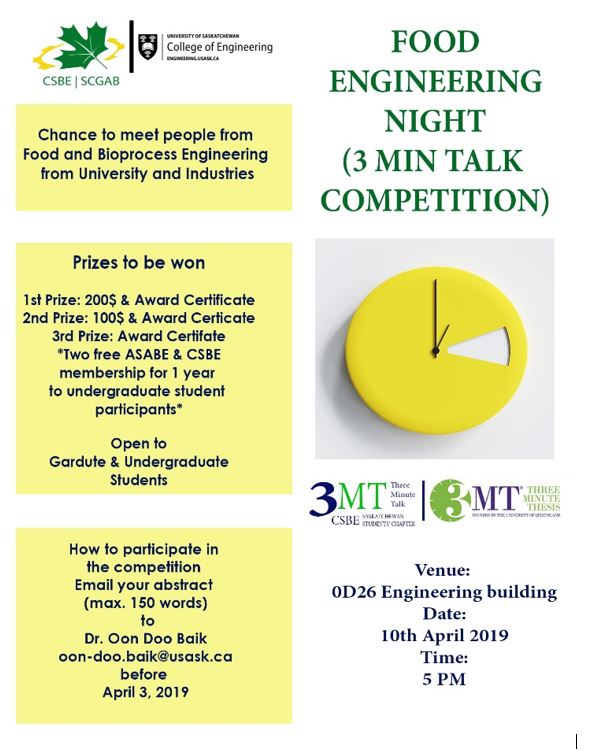
Food Engineering Night Poster
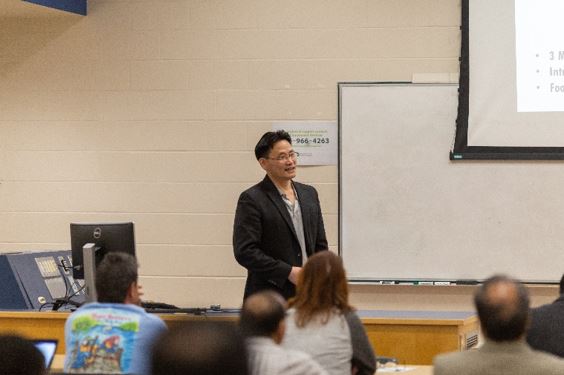
Dr. Baik is briefing the event.
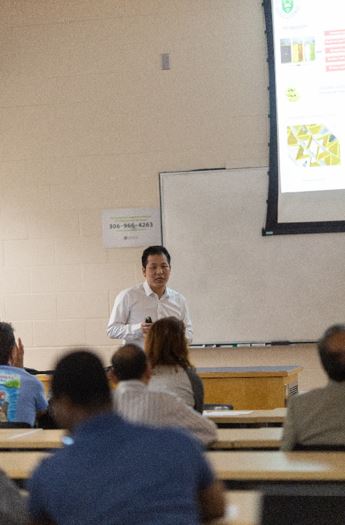
One of the competitors, Li Zhou (Biological Engineering) is presenting his work.

Audiences
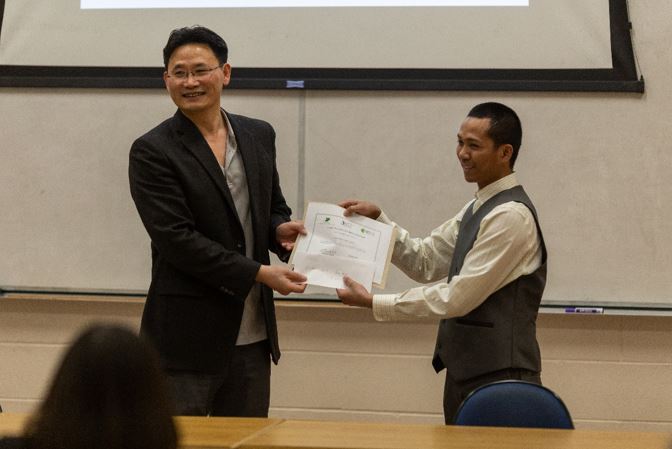
1st place winner, Roland Macana is receiving a certificate and cash prize
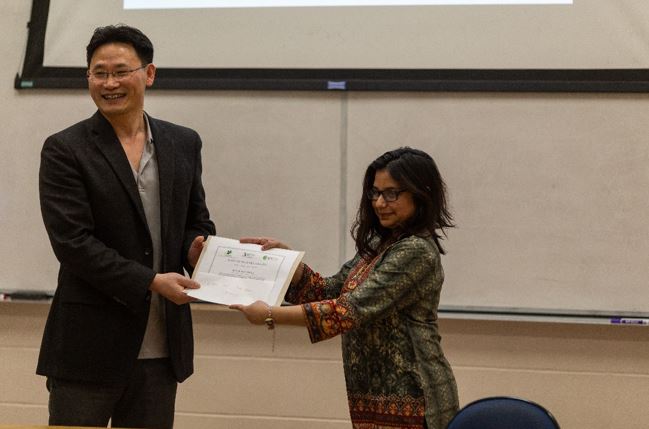
2nd place winner, Alivia Mukherjee1 is receiving a certificate and cash prize
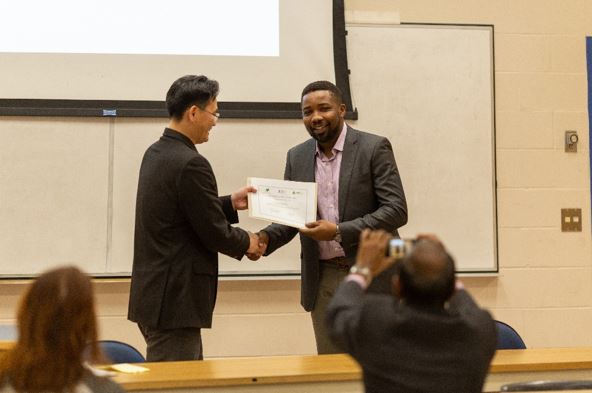
3rd place winner, Dayo Oke receiving a certificate
Presentation slides and abstracts from top three winners
1st place: Roland Macana, Disinfestation of insect pests in stored wheat grains using 50-ohm radio frequency (RF) heating system

Traditional methods for disinfestation of insects in stored grains are using chemicals. However, they have been prohibited because of the destructive effect on the ozone layer and the health hazards caused by excessive chemical residues. Therefore, non-chemical methods were proposed to be an alternative for chemical methods of disinfestation. Radio frequency (RF) heating for disinfestation is a non-chemical method. Thus, this research determined the mortalities of the rusty grain beetles in stored wheat grains using the advanced 50-ohm RF heating system and investigated the qualities of the wheat grains before and after RF treatment.
The results showed that the disinfestation of insects in stored agricultural materials using 50-ohm RF heating was possible without degrading the important qualities of the host materials.
2nd place: Alivia Mukherjee, Carbon dioxide capture exploiting novel activated carbon from spent

The increased worldwide demand for energy, intensifies the combustion of fossil-based fuels with escalated greenhouse gases concentration in the ambient atmosphere. The increase of recalcitrant carbon dioxide (CO2) concentration in the ambient air has become the significant reason for the global warming scenario as a primary contributor. To alleviate the catastrophic environmental scenarios, a quick mitigation effort is required. CO2 capture and storage (CCS) technologies are becoming a very active research area motivated due to the increasing awareness of global warming.
The utilization of the activated carbons (ACs) instead of the current state of the art technology, which is the chemical absorption based on amine scrubbing, is promising as it avoids higher energy penalty encountered in regeneration step. In Canada, coffee accounts for almost three-fourth of the hot drinks market. Instead of wasting this material, massive amount of varying organic compounds contained in this can be exploited for the preparation of higher value-added products for CCS technology.
The purpose of this work is to provide critical analysis of the role of spent coffee grounds (SCG) as a source of ACs. This can help in providing future direction of the ACs from SCG for CCS in an industrial setting.
3rd place: Dayo Oke, Innovative removal of Anti-Nutritional Factors and Negative Flavours in Lentil and Chickpea using Electromagnetic Waves

Lentil and Chickpea are two of the important pulses whose nutritional factors are important to agricultural and food industries. However, there are certain non-nutritive bioactive components known as anti-nutritional factors (ANFs) in these pulses that have prevented the direct application of their proteins in the mainstream food industry. Negative flavour (NF) on its own has limited the expansion of their ingredients into major food applications. There have been several attempts to remove these components using various methods; however, many of them have resulted in increasing the amount of these components. Therefore, our aim is to treat these pulses with electromagnetic wave, particularly radio frequency (RF) heat treatment. RF will assist in their removal without altering the structure of nutritive bioactive components or damaging the seeds. RF removal of these components will be possible due to the polarity of the ANFs and the volatile gaseous nature of NFs.

